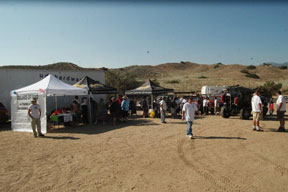The devastating earthquakes and tsunamis that hit Japan have many people thinking about survival techniques. Especially here in California, where we’re constantly wondering when the Big One will hit. I’ve discussed various aspects of survival in other columns, including Your Gear Is Not Complete Without An Emergency Packet! and Get Layered Before The Big One Hits Reading those you’ll notice that we discuss preparedness on a larger scale. That is, we start on the outside and work our way literally closer to your body. In this column we’ll discuss survival at the micro level: creating a survival kit that you can tuck in a shirt or pants pocket. You can never be too prepared nowadays. You may not face an earthquake and tsunami where you live, but other types of disasters can hit. Tornadoes, blizzards, severe storms; even civil unrest can cause a disruption. Are you prepared to go it alone for a few hours or longer? Because I spend so much time off road, I have multiple survival kits, including stuff I carry in a pocket. This column will show you how to create a viable pocket-sized survival kit. Take the time to build one. It could save your life someday. The first challenge we notice is finding the proper container. As you know, pockets aren’t very big. Yet we still want to pack a lot of useful items in this survival kit. You’ll want something that’s roughly 3” x 5” and no more than about 1” deep. I like Altoids® boxes, but they’re rather shallow. Metal is better than plastic, as you’ll see in a moment. If you decide to go with plastic, take a look at the line of Pelican micro cases. They are easier to acquire and are water tight. What do you include? Here is where we review the basic components. A good survival kit includes matches, a flashlight, water, whistle, map and compass, knife, 1st aid kit, extra food and extra clothing. Some people like to add a water container, paper and pencil, and toilet paper.
Wrap the seams of the Altoids box with tape. Put as many layers on as you like. You might need some tape! Take the time to create a pocket survival kit (or two with the extra supplies). If you ever need one, you’ll be so glad you did. # # # # # |
|
|||
Related Articles from Badlands Off-road Adventures |
||||
Did you miss the previous article? |
||||
Advanced Beginner Clinic May 15
The clinic is held in the El Paso Mountains near Mojave CA. The goal is to help you get a "better feel" for tire placement and to visualize the obstacles as they move into your blind zone. You will gain more behind the wheel experience combined with picking lines. The difficulty level is one step higher than the basic class and you can expect some pin striping. More Details... You can register directly at http://www.4x4training.com/calendar/calendar.php#Basic2 |
||||
Winch Clinic May 21, 2011
This one day clinic starts with the basics. By the end of the day you will be safely rigging some complex recoveries. Let me know if you are interested. More Details... You can register directly at http://www.4x4training.com/calendar/calendar.php#Winch |
|
|||
Rocks Clinic June 18
The Class will be in Johnson Valley. This is an introduction to Rock crawling but it is not on "baby" rocks. We take out time and stress careful wheel placement. We use spotters for difficult sections. You learn by inspecting the obstacle and predicting the line; by watching others try their line; by experiencing it yourself; and by the coaching. We recommend you repeat the training several times. You will be much more relaxed the second time over the same obstacles and you will pick up on little details missed the first time. More Details... You can register directly at http://www.4x4training.com/calendar/calendar.php#Rocks |
||||
Free Customer Appreciation Event & trail Ride
|

|
|
|
I hope to see you on the trails!
Tom Severin, President
Badlands Off Road Adventures, Inc
4-Wheel Drive School
310-374-8047
http://www.4x4training.com
Make it Fun. Keep it Safe.
#####
If you find this information valuable, please pass it on to a friend. You can forward them the email.
If you received a forwarded copy of this newsletter and would like to subscribe for yourself, go to:
www.4x4training.com/contacts.html
and follow the instructions to join our mail list.
Want To Use This Article In Your Magazine, E-Zine, Club Newsletter Or Web Site?
You are welcome to use it anytime, just be sure to include the following author/copyright information:
Tom Severin, 4x4 Coach, teaches 4WD owners how to confidently and safely use their vehicles to the fullest extent in difficult
terrain and adverse driving conditions.
Visit www.4x4training.com to develop or improve your driving skill.
Copyright 2011, Badlands Off-Road Adventures, Inc.
| Back | | Phone 310-374-8047 |